It’s time for inaugurating a subsection of my Indie Fighting Game Thursday series: Deep Doujin Dive, in which we delve into obscure, rare or not very well known Japanese indie fighting games and review their mechanics, aesthetic and appeal. To kickstart the series, we begin with FateAxis 2 ~ The Fragment, a game by Rokusujio!
A game lost to the mists of time
The Community Lab is a Discord server created by PolarBAir to gather together a motley crew of obscure fighting game enthusiasts — like the ever present GriffyBones — in order to lab and unearth new tech from a limitless series of barely known games, ranging from broken NES bootlegs to more recent Steam games that could be classified as rightful kusoge.
Among the fine folks populating the server, there is also a good amount of preservationists — people like me who want to avoid older games to be deleted from the internet or be forgotten in the sands of time. One of these game historians, a user called Neo M, approached me to help him to run an old Windows 98 game on a modern machine. That game was FateAxis Omega Edition.

One of the few available screenshots of FateAxis Omega Edition. There isn’t a lot of documentation around the net, and the game cannot run on any modern system due to some memory shenanigan. The game can be still downloaded from Vector, if you want to take a chance at it. The above picture comes from the HTML manual that was included with the game itself. [Link]
Despite all our best efforts, we were defeated by the sheer amount of DLL and memory exceptions we found along the way, after several hours of fruitless attempt. Thus, we decided to give up and call it a day — or, in my case, a night, as I had researched obscure Windows forums until 3AM to try and run the game, just for the chance to play as a purple demon catgirl — in vain).
After this debacle, I just let it go and almost forgot about the game. Until…
Serendipity strikes again
… until one day, several months later, I stumbled upon a tweet showcasing an arcade version of its sequel, FateAxis 2 ~ The Fragment. Intrigued and still wounded by my failure with the prequel, I obtained a link to the PC version of this sequel thanks to a Japanese player, KDOKBNZY, who directed me to the official website of the game.
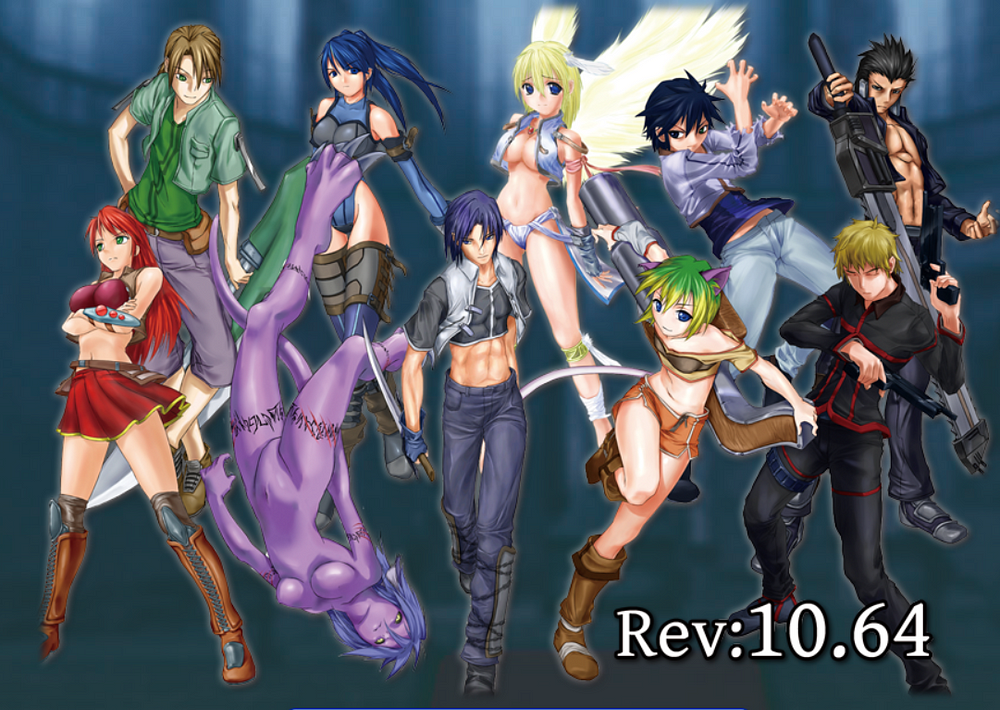
The sequel I didn’t know I wanted. Featuring not one, but TWO catgirls too.
After downloading the exe, reading the manual thanks to the DeepL translator and quickly configuring Joy2Key, I have booted up the game, eager to see what it was all about. Little did I know that I would have spent the next hours fiddling with training and arcade mode.
A low poly air dasher with 3D movement
FateAxis 2 ~ The Fragment is by no means an easy game to describe. You have the basics of a 2D game, with Light, Medium and Heavy attacks, all wrapped in what looks like PS2 graphics. Then, you find out that you can side step in the third dimension at the press of a button. Then, you discover the air dashes. Suddenly, you find yourself stringing light into heavy into light again, because there is infinite reverse beat on hit or block: you can shuffle through your normals at will, until the pushback has the best of you.

“No.4”, the demonic purple catgirl is lowkey my favorite character in this game bar none. She has access to three air dashes and some very sick combo routes. This super is unique in FateAxis, as it increases her ki gauge too, which can be used to get access to enhanced versions of her special moves.
Each character has also access to a launcher, universally assigned to down plus Heavy, which is very punishable on block, cannot be canceled into another normal, but can be jump canceled even when blocked. Speaking of which, this game has air dashes, double jump and air blocking too, which allow for some stylish aerial raves.
Sidesteps are slow-ish and not that useful, unless to reposition yourself to avoid being cornered or to evade some very linear projectile or raw super.
There are also attacks that hit a grounded opponent, potentially starting a juggle at the corner.
There are standard grabs, which are performed by pressing back plus Heavy near the opponent and always switch side. I am not sure if they can be teched in any way, though.
Super meter resets every round and can be filled with up to three stocks. Almost all super moves are universally performed by inputting a half circle forward or backwards followed by a specific button and consume one stock. More specifically, this game doesn’t have any really difficult motion, only quarter circles for specials and half circles for supers.
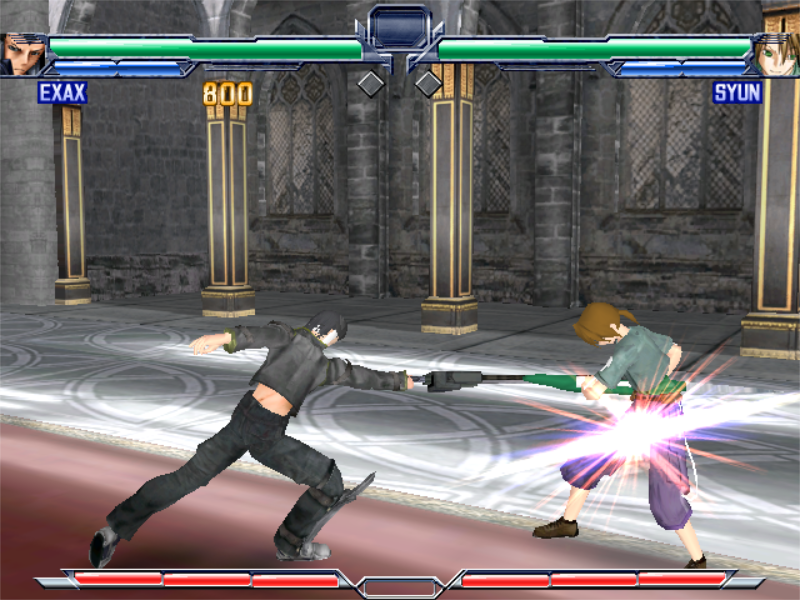
Exax’s blade should be banned by Geneva’s convention for being absolutely brutal in terms of raw damage. Three of his Heavy attacks in a row can deal as much damage as a super move, if not more.
Pushback for ages
Corner pushback is fairly punishing. If you start a corner combo, chances are that you’ll need to stop it after around 10 hits, due to the fact that with each following hit, the attacker is flung further and further away, thus preventing additional moves to connect.
There’s a sane amount of pushback in the middle of the stage too, and the number of possible OTG attacks is actually limited by design, thus preventing “easy infinites”.
However, the PC version of FateAxis 2 has some hidden weaknesses in this department, as a clever use of cross-under air dashes can INDEED trigger a dreaded infinite combo. I was made aware of this by Abbock on Twitter, who later provided a video by Sleepmode, which shows how this works and is linked right below:
But, okay, now that the elephant in the room is addressed (and probably even fixed in the new arcade version of the game), I can tackle the most unique, interesting part about the mechanics: the FA gauge.
Missing buttons and where to find them
If you look under the energy bar, you will notice a short blue bar divided into two segments. That is the FA (FateAxis) gauge. Initially, I had no idea of how it worked, even after reading the instructions. It wasn’t clear to me which button was mapped to the actions that made use of the bar.
I am a physicist, I solve problems. And my problem was understanding why any combination of buttons I was pressing didn’t trigger any of the special actions. The in-game input mapping didn’t help, as it was fully in Japanese — a language I still have several troubles understanding. So, I went the usual way and tried to reverse engineer the issue.
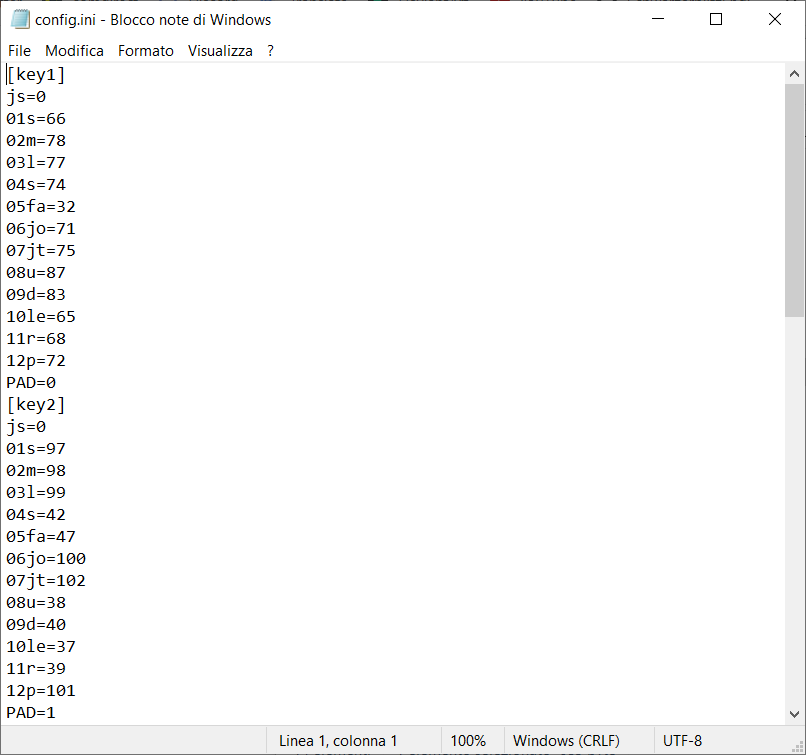
What you see is a little success in reverse engineering, which allowed me to map the missing button to the J key by the sheer brute force knowledge of ASCII codes.
First thing first, I have found a plain text file where options were saved (conveniently called “config.ini”) and located the two missing buttons. One [05fa] was simply mapped to spacebar, but did nothing on its own, while the other [04s] offered a more interesting challenge: It was apparently mapped to a character not available on US keyboards (the lowercase n), thus not available for use. After a quick surgical operation and with the help of a practical ASCII table, I edited the file to map it to the J key, reconfigured Joy2Key and started the game again.
A complete game changer
The result was beyond my expectations: The FA bar can be used to apply three different extra effects that change consistently the way the game is played. These actions can be all performed while not being hit by the opponent — even during an attack or the startup of a super move. Only one of them can be active at any time, though.
Since the FA gauge resets during rounds, it is extremely beneficial to make use of those as much as reasonably possible.
- pressing FA + Light Attack triggers Attack Mode for a base cost of 1/10 of your FA gauge, and makes your character flash red. This increases the damage dealt by a whopping 45% and increases the damage received by 20% for around one/two second. I have seen the AI use this during a super move startup, to maximize its damage output, and with good reason;
- pressing FA + Medium Attack triggers Defense Mode for a base cost of 1/5 of your FA gauge and makes your character flash green. This gives your character absolute armor against any non-grab attacks for the next two seconds, but reduces the damage dealt by your attacks by 15%. I personally found this to be the most useful among the three to go through arcade mode;
- pressing FA + Heavy Attack triggers Combo Mode for a base cost of 1/8 of your FA gauge and makes your character flash blue. In this mode, your character’s speed is increased and some special moves can be freely cancelled into e.g. air dashes, normals or supers, allowing for safer pressure or enhanced combo ability. In its minimal meter usage, it lasts for around two seconds and expires after the first successful cancel. While in combo mode, the damage dealt is cut by 15%, and the damage received is increased by 20%.

The FA actions explained. I had to use a good online translator, because my Japanese is nothing to write home about, but — boy — it was worth it!
By inputting the same FA action several times in a row, you can actually extend their duration by up to around 8 seconds, consuming the full bar. Switching mode invalidates the remaining time for the previous FA action. Also, notice that while Attack and Defense mode are ongoing effects, Combo mode will expire after the first successful cancel.
ZA WARUDO — I mean, Concentrat Shift
There is one last action that can be performed by consuming FA gauge: Concentrat Shift, which is a weird mix between a combo extender and a disruption tool. This move is performed by pressing FA plus [04s] (the button that I mapped to J when fiddling with the config files). While this button alone has no effect, using the above combination during ANY game state (idle, attacking, being hit) will slow down the opponent to 1/4 of their normal speed, allowing for some creative extensions or for messing off the timing of their own combos.
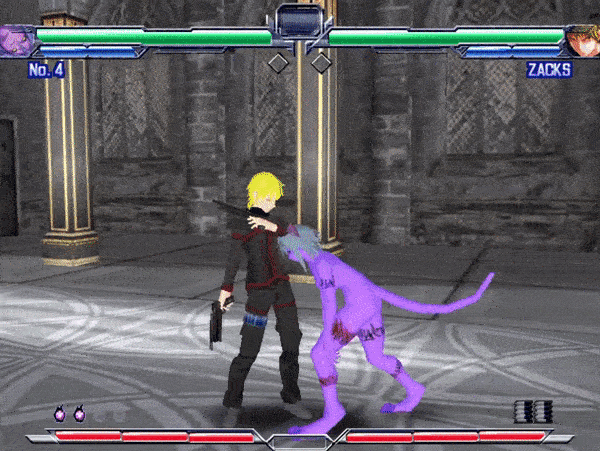
Imagine my face after finding out about this pseudo-roman cancel with time stopping abilities. PSA: taunts are performed by pressing both sidestep buttons at the same time. I Joy2Key’d them to Back/Select for practical purposes though.
Concentrat Shift is a welcome addition, adding even more flexibility to an already very flexible combo system, but to be honest I have found it slightly underwhelming as a defensive mechanics, due to Defense Mode being superior for a smaller cost.
Ten different fates
FateAxis 2 ~ The Fragment offers 10 characters, each with two alternate colors. All of them are voice acted, except Reo and Zacks, who have no voice clips and whose entris in the manual list no backstory — maybe they were the last character added, but I found no confirmation of it.
There is no real shoto in the game, but there is one absurdly high damage swordsman (Exax), a more balanced wind/earth elemental swordsman (Syun), an ice mage with terrifying pressure (Rine), a rushdown fire bruiser (Iria) a gun-fu expert (Zacks), a speedy twin-blade wielder (Varth), a fast rushdown character with power up mechanics (Reo), an angel with big disjoints, a stripperiffic outfit, and a name which is almost impossible to pronounce without twisting my tongue thrice (now, say it with me: ARSJUZMOW), a catgirl with a gun (South) and another demon catgirl — without a gun, but with extreme air mobility and a way to enhance her special moves (“No.4”).
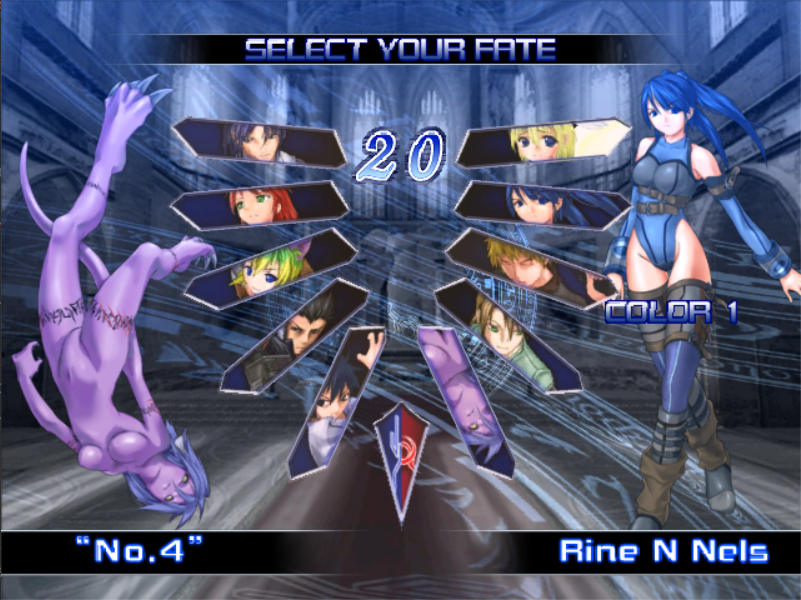
The cast feels pretty unique, with each character focusing on one specific aspect that makes them stand out in the context of the game.
The good, the bad and the ugly
The game offers some basic, run-of-the-mill fighting game modes: arcade, training, local versus and versus CPU, with difficulty level settings. Arcade mode is a set of eight matches against predetermined opponents, with increasing difficulty. There is no reward for clearing an arcade run (no color unlocks or arcade endings), and there are no continues either: if you the AI defeats you, you need to restart from the title screen. Fortunately, the difficulty isn’t too punishing and if you spent a little bit of time in training mode and learned how to use Defense Mode, it shouldn’t be impossible to clear it once.
Aside from this, the game offers the possibility to move the camera while a match is paused, allowing for some creative photo sessions.
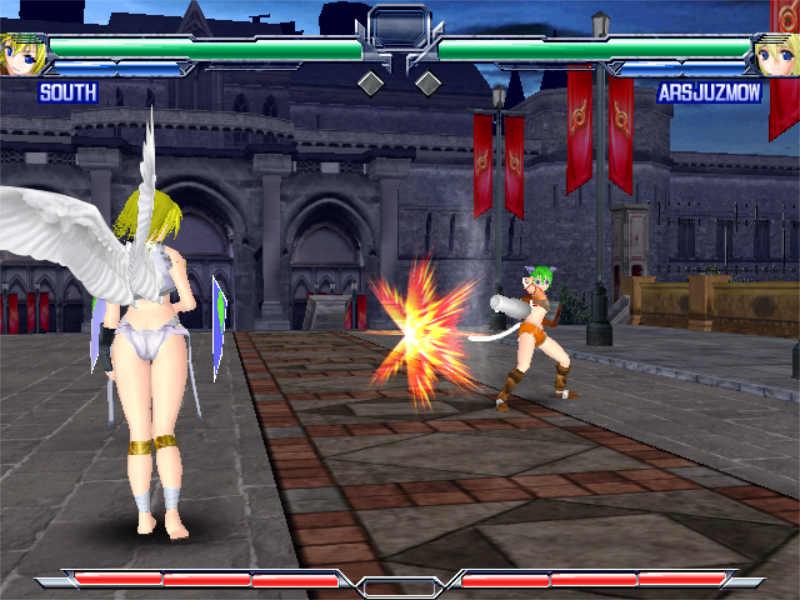
Photo mode can actually be used to uncover some of the tricks used in rendering the game effects, for example the fact that South’s projectiles are actually a set of 3 intersected flat textured planes.
Aside from these standard modes, though, there isn’t a lot to do. The amount of stage is minimal (only two, with different sizes), with a grand total of two BGMs that play at random. The hit sound effects and the combo counter have some similarities with those of Guilty Gear X and animations can be at times blocky or not really smooth.
However, despite its shortcomings, the game is legitimately fun to play and is worth a shot, even if only for some original ideas that I haven’t found in many other games around. FA Actions alone are a reason why this game deserves a honest try.
Wait, what about the arcade version?
Short answer: it exists, but only in Japan. It’s an evolution of the PC version, with enhanced 3D models, additional character colors and probably some balance changes. Still, I have no idea if it will ever come out of the land of the rising sun. The developer has posted some screenshots from it, while promoting some local tournaments. One can hope we will be able to try it out sooner or later and see how much the game has evolved in its latest incarnation!
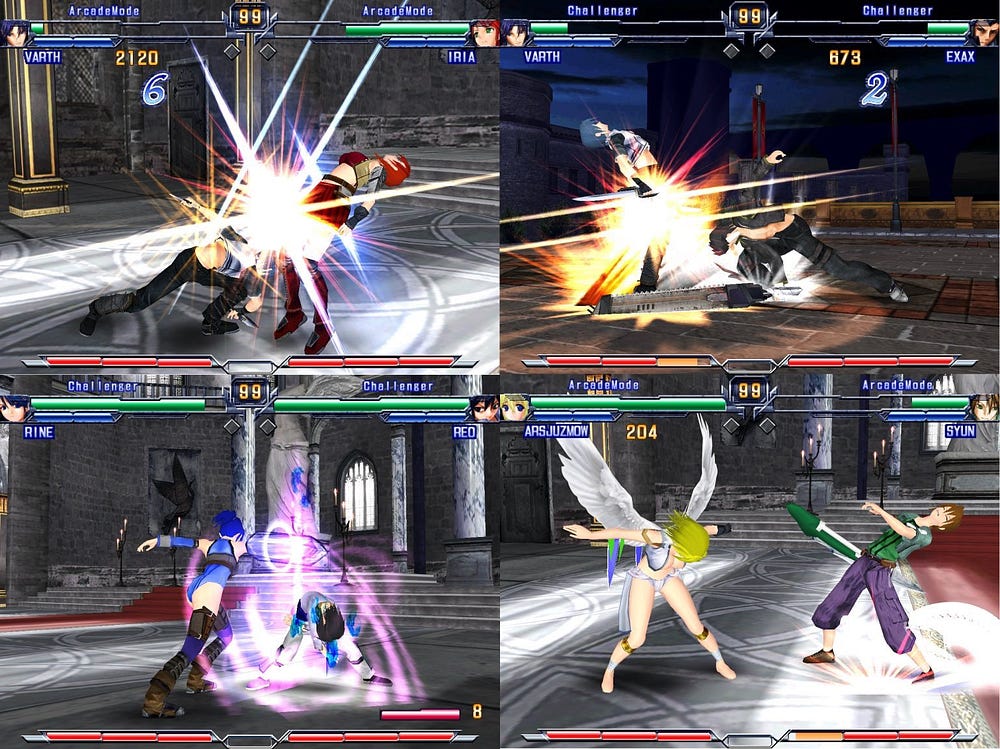
The game has a stylish phot mode that allows for turning around the camera while it’s paused and can be used to take some nice screenshots. The above pictures are all from the developer’s account, and come from the updated arcade re-release of the game. [Source]
[Update – 20.11.2021]
I have reached out for the developer on Twitter to ask some questions about the arcade re-release. There are some major changes that have been confirmed [source]: the super bar is shortened from three to two segments, and Concentrat Shift uses standard super gauge instead of the FA gauge. FA gauge is reserved to FA skills only. Also, Concentrat Shift has different properties if activated while being comboed by the opponent.
As far as infinite combo go, the developer doesn’t exclude that they might still be there, but thinks that the changes to Concentrat Shift and the heavy damage scaling are good balancing tool to counter them [source].
Footage from the arcade version linked to me by KDOKBNZY in The Community Lab server. Notice that the super meter is now composed of two segments only and that Concentrat Shift uses normal super meter instead of FA gauge.
Game summary
Name of the game: FateAxis 2 ~ The Fragment
Developer: Rokusujio
Available on: PC (Developer’s website)
Price: Free
Year of release: 2015 (Rev. 10.64), 2018 (arcade edition, Rev. 10.81)
Engine: unknown (the game crashes if it is added manually to Steam and cannot be recorded via Windows Game Recorder, so it’s most likely some custom DirectX solution)
Netcode: none (Parsec)
Status: complete
In one sentence: 2.5D fighting game with 3D environment, air-dashes, time stop roman cancels, a power-up system, and two catgirls.
Special thanks to the amazing people at The Community Lab server for sharing knowledge about this game and making me aware of it. Thanks to KDOKBNZY too for helping me translating some of the replies I have received from the dev, as my Japanese is extremely lacking!
If you are interested in more coverage about indie fighting games, you can find me on Twitter at @AndreaDProjects

